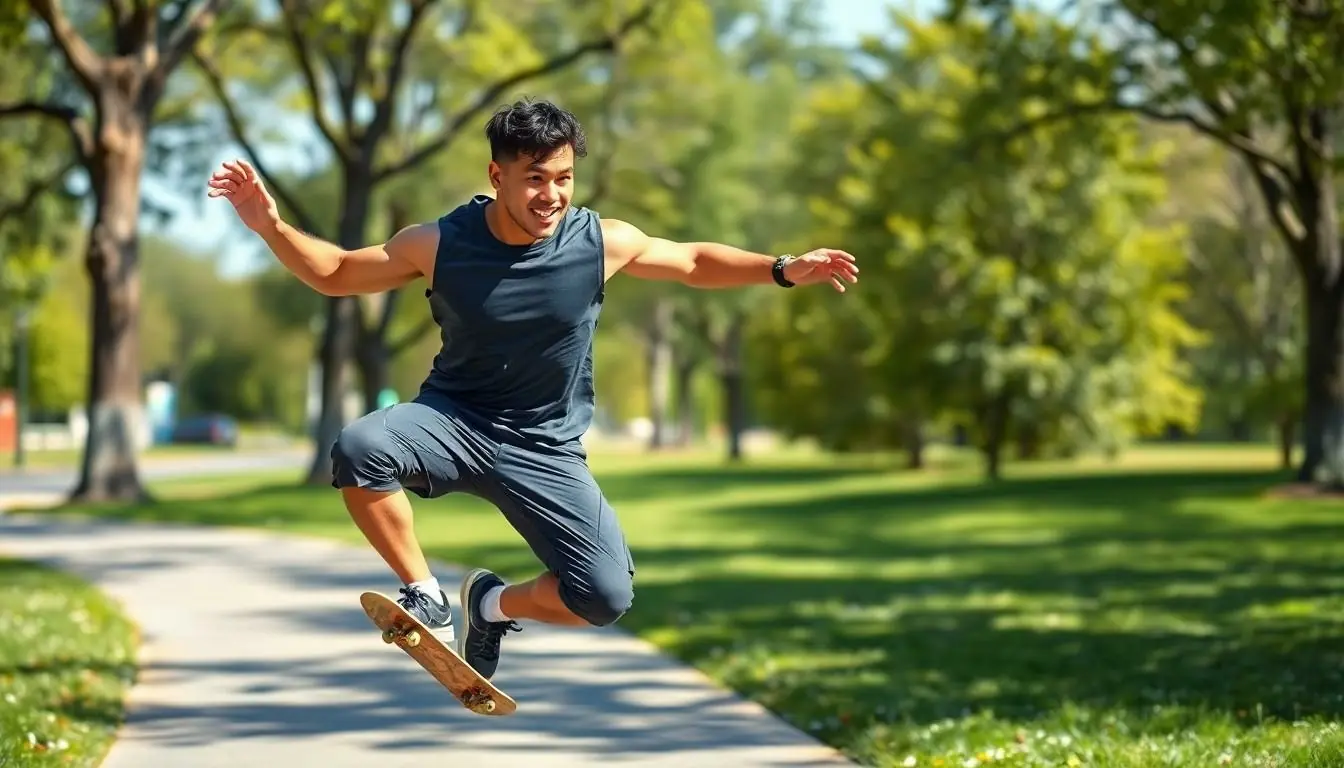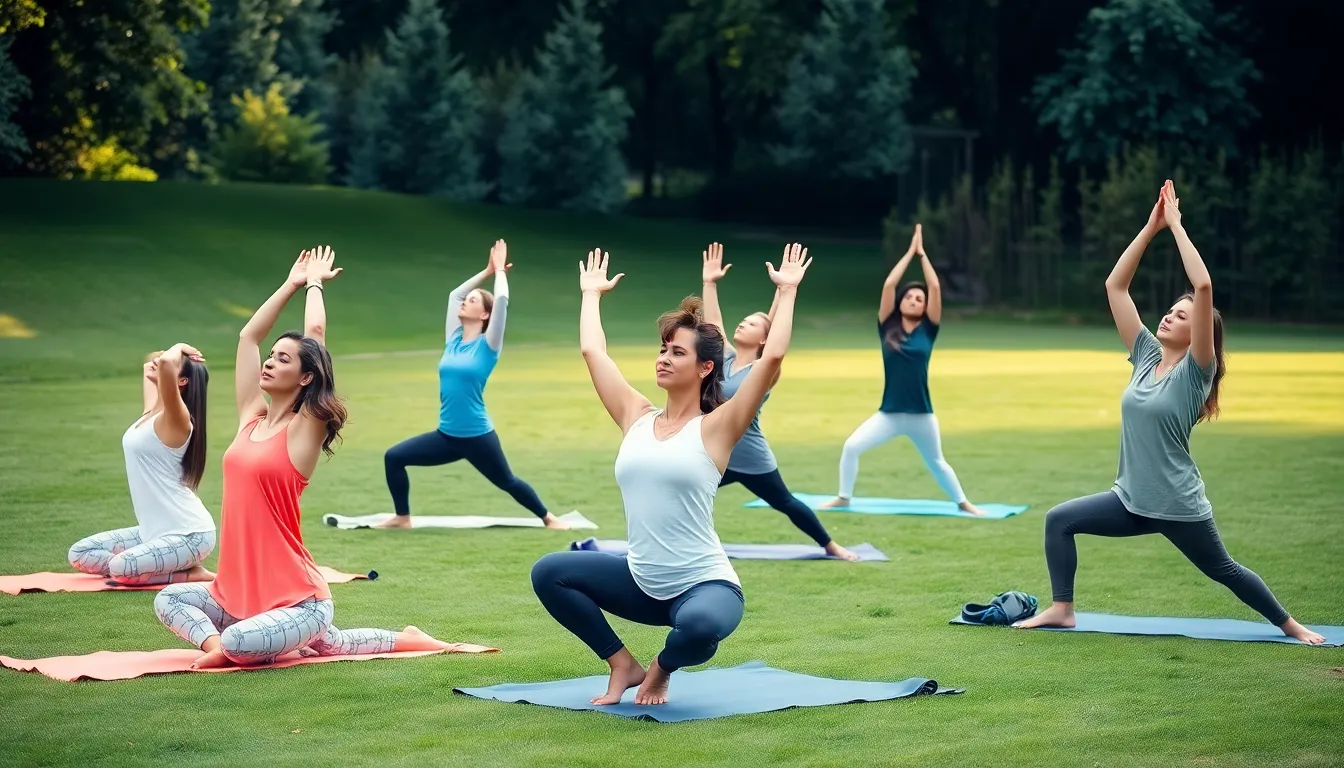Looking to spice up your workout routine? Skater jumps might just be the answer. This dynamic exercise not only gets the heart racing but also transforms you into a powerhouse of agility and strength. Imagine gliding through the air like a figure skater, minus the sequins and icy rink.
Table of Contents
ToggleOverview of Skater Jumps Exercise
Skater jumps enhance workout routines by combining strength, agility, and cardiovascular benefits. This exercise mimics the lateral movements found in figure skating, promoting dynamic fitness without specialized equipment.
Definition and Purpose
Skater jumps involve lateral leaps that target muscles in the legs, core, and glutes. Participants push off one leg and jump to the opposite side, landing on the opposite leg. This movement mimics the motion of skating, emphasizing stability and balance. Athletes and fitness enthusiasts utilize skater jumps to develop explosive power and coordination, essential for various sports and activities.
Benefits for Fitness and Agility
Skater jumps boost overall fitness by increasing heart rate and promoting calorie burn. Engaging multiple muscle groups aids in building strength and endurance, leading to improved performance in other exercises. Agility benefits arise from the rapid lateral movements, enhancing reaction time and balance. Incorporating skater jumps into routines fosters greater flexibility and strength, supporting various athletic pursuits.
How to Perform Skater Jumps

Skater jumps require precise movements for maximum effectiveness. Following proper form ensures safety and promotes strength development.
Proper Form and Technique
Start by standing with feet shoulder-width apart. Bend the knees slightly for stability. Jump laterally to the right while pushing off the left foot. Aim to land on the right foot, shifting weight smoothly. Maintain a low center of gravity during the jump. Engage the core to stabilize the upper body. Alternate sides with each jump, moving quickly and fluidly. Focus on keeping the movements controlled to prevent injury. Utilize arm swings to help generate momentum and balance throughout the exercise.
Common Mistakes to Avoid
Landing too hard can lead to injury. Avoid jumping without proper warm-up to prevent strain. Not engaging the core makes it difficult to maintain stability. Skipping the lateral aspect of the jump limits effectiveness. Failing to alternate sides disrupts the flow and reduces benefits. Performing skater jumps too quickly can compromise form, leading to improper technique. Keeping arms too close to the body decreases balance and momentum. Lastly, neglecting to breathe during the exercise can affect endurance and performance.
Variations of Skater Jumps
Skater jumps can be modified and advanced to suit various fitness levels. These variations enhance the benefits of the exercise while keeping the routine fresh and engaging.
Beginner Modifications
Start with a simpler version of skater jumps to build confidence and ensure proper form. Perform lateral steps instead of jumps, allowing the body to adapt to the movement. Focus on landing softly on the trailing leg to prevent strain. Incorporate a balance pause after each step to engage core muscles for stability. Adding lighter arm movements can improve coordination and help maintain balance. Gradually increase the distance of each step as strength and control improve.
Advanced Progressions
For those ready for a challenge, adding depth and intensity to skater jumps can enhance workout effectiveness. Implement plyometric variations, such as explosive jumps with height, to engage more muscle fibers. Use resistance bands around the thighs to increase difficulty, intensifying the workout. Incorporate single-leg skater jumps for added balance work and focus on explosive power. Include burpees between sets for a more exhaustive cardiovascular challenge. Transitioning from side to side with greater speed can also improve agility and coordination.
Incorporating Skater Jumps into Your Workout
Skater jumps fit seamlessly into any workout routine, providing a dynamic way to enhance strength and agility.
Sample Workout Routines
Incorporate skater jumps into high-intensity interval training (HIIT) sessions. Alternate 30 seconds of skater jumps with 30 seconds of rest for a total of 10 rounds. Combine skater jumps with other exercises like push-ups or burpees for varied routines. Include three rounds of 15 skater jumps followed by a different exercise to maximize calorie burn. For strength training, integrate skater jumps with weightlifting sessions, performing them as a cardio finisher to elevate heart rate.
Frequency and Duration Recommendations
Perform skater jumps two to three times weekly for optimal results. Start with 10 to 15 minutes per session as endurance builds. Increase duration gradually, aiming for 20 to 30 minutes as strength and confidence grow. Schedule sessions on non-consecutive days to allow recovery and avoid overuse injuries. Remember to include warm-ups and cool-downs in each session to enhance flexibility and prevent injury. Consistent practice of skater jumps significantly increases overall fitness levels.
Skater jumps are a powerful exercise that can elevate any fitness routine. They not only enhance strength and agility but also provide a robust cardiovascular workout. By incorporating this dynamic movement, individuals can improve their overall fitness while enjoying a fun and engaging exercise.
With proper form and technique, skater jumps can be safely performed by anyone, regardless of fitness level. Whether starting with basic lateral steps or advancing to explosive variations, the adaptability of skater jumps ensures they remain effective and challenging.
Regularly practicing skater jumps will lead to significant improvements in muscle strength, coordination, and endurance. Embracing this exercise can transform workout sessions into exciting challenges that yield impressive results.





